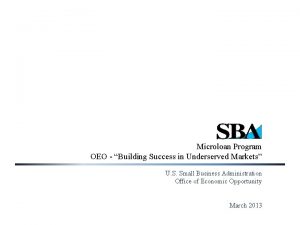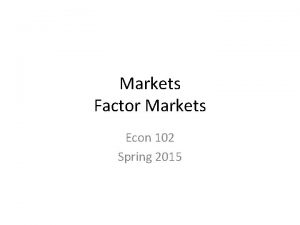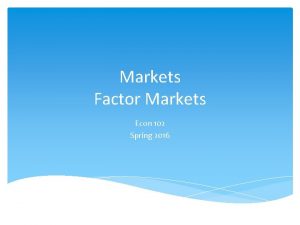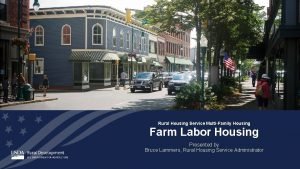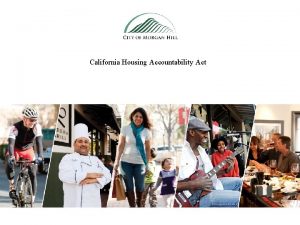Doing More for Underserved Housing Markets Overview of














- Slides: 14

Doing More for Underserved Housing Markets Overview of Fannie Mae’s Duty To Serve Plan © 2017 Fannie Mae. Trademarks of Fannie Mae.

What is the Duty To Serve Rule? n A regulation issued in December 2016 by the Federal Housing Finance Agency n Driven by the Housing and Economic Recovery Act (HERA) of 2008, which guides our activities at Fannie Mae every day n It requires Fannie Mae and Freddie Mac to improve access to mortgage financing for those of modest means in three housing markets posing persistent challenges: q Manufactured housing q Affordable housing preservation q Rural housing © 2017 Fannie Mae. Trademarks of Fannie Mae. 2

Why is Duty To Serve important? n Helps homeowners and communities q Targets families of modest means q Focuses on underserved market segments q Sets the stage for broader economic benefits n Creates growth opportunities for the industry q Explores unrealized market opportunities q Encourages innovation to address market challenges and reduce costs n Aligns with Fannie Mae’s mission q Builds on what we do best—tackling tough housing challenges q Promotes access to safe, sustainable, and affordable housing options q Manages risk to protect lenders, homeowners, and taxpayers © 2017 Fannie Mae. Trademarks of Fannie Mae. 3

How are we approaching this challenge? We’ve developed a three-year Underserved Markets Plan as required by FHFA, proposing activities to address the housing challenges in each market. Our approach is to: n Analyze – Use research and analysis for a data-driven market understanding n Test and learn – Execute pilots and evaluating product and program changes n Partner and innovate – Listen and work closely with market-based experts n Do what we do best – Use the power of the secondary market to attract private capital © 2017 Fannie Mae. Trademarks of Fannie Mae. 4

Who and where are we trying to help? n Nationwide – We’re serving very low- to moderate-income families (earning Area Median Income) in each of the three underserved housing markets n Rural Multifamily - Increasing Delivery of 5 to 50 unit Loans n LIHTC – Reenter LIHTC Equity Investments n Rural Housing Market – We’re targeting specific high-needs populations and regions, including: q Middle-Appalachia, Lower Mississippi Delta, and colonias q Rural tracts in persistent poverty counties q Native Americans and agricultural workers © 2017 Fannie Mae. Trademarks of Fannie Mae. 5

Rural market: Combined high-needs rural areas * Under the DTS rule, a colonia must be a community identified under a federal, State, tribal, or local program. Colonia information shown on the map above is courtesy of the State of Texas and the University of New Mexico. © 2017 Fannie Mae. Trademarks of Fannie Mae. 6

2017 FHFA Rural Areas MSA 2017 Rural Tracts © 2017 Fannie Mae. Trademarks of Fannie Mae. 7

Rural Housing: Multifamily Actions n Purchase multifamily loans in Middle Appalachia, the Lower Mississippi Delta, and the colonias. n Purchase multifamily loans that support affordable housing for Native Americans and agricultural workers. n Re-establish our Low Income Housing Tax Credit (LIHTC) investment capacity. n Include LIHTC equity investments in the multifamily work-plans for high-needs rural regions and high-needs rural populations. n Expand Small Loan (5 to 50) purchase © 2017 Fannie Mae. Trademarks of Fannie Mae. 8

Duty to Serve: How can you help? Look for opportunities to help us implement our plan in 2018 and beyond: n Engage and innovate with Fannie Mae representatives and industry partners n Support future research, outreach, and pilots. We welcome your ideas and creativity! © 2017 Fannie Mae. Trademarks of Fannie Mae. 9

Where can you get more information? fanniemae. com/dutytoserve www. fhfa. gov/dts © 2017 Fannie Mae. Trademarks of Fannie Mae. 10

Rural market: Middle Appalachian region © 2017 Fannie Mae. Trademarks of Fannie Mae. 11

Rural market: Lower Mississippi Delta region © 2017 Fannie Mae. Trademarks of Fannie Mae. 12

Rural market: Persistent poverty counties © 2017 Fannie Mae. Trademarks of Fannie Mae. 13

Rural market: Example of the colonias region* * Under the DTS rule, a colonia must be a community identified under a federal, State, tribal, or local program. Colonia information shown on the map above is courtesy of the State of Texas and the University of New Mexico. © 2017 Fannie Mae. Trademarks of Fannie Mae. 14
 Lirik lagu more more more we praise you
Lirik lagu more more more we praise you More more more i want more more more more we praise you
More more more i want more more more more we praise you Underserved backgrounds
Underserved backgrounds Risks of doing business in emerging markets
Risks of doing business in emerging markets Anything worth doing is not necessarily worth doing well
Anything worth doing is not necessarily worth doing well Doing nothing is doing ill
Doing nothing is doing ill The more you take the more you leave behind
The more you take the more you leave behind Knowing more remembering more
Knowing more remembering more The more you study the more you learn
The more you study the more you learn More love to thee o lord
More love to thee o lord Aspire not to have more but to be more
Aspire not to have more but to be more More choices more chances
More choices more chances Newton 1st law
Newton 1st law Human history becomes more and more a race
Human history becomes more and more a race Romarriket tidslinje
Romarriket tidslinje
















